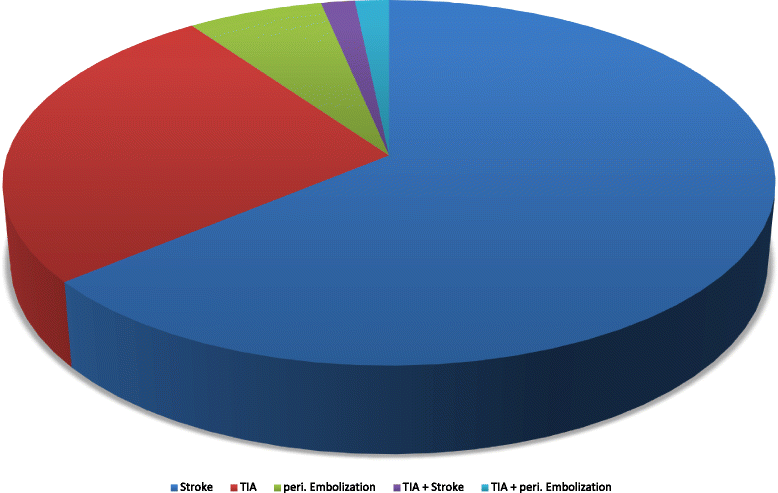Mid-term results of interventional closure of patent foramen ovale with the Occlutech Figulla® Flex II Occluder
- PMID: 27832757
- PMCID: PMC5103606
- DOI: 10.1186/s12872-016-0391-3
Mid-term results of interventional closure of patent foramen ovale with the Occlutech Figulla® Flex II Occluder
Abstract
Background: Patients with a patent foramen ovale (PFO) who suffered from stroke, TIA or peripheral paradoxical embolism are at substantial risk for recurrent neurologic events and in need for secondary prevention. Interventional closure of PFO has been performed for over 20 years. Numerous devices have been developed and used for treatment. We investigated PFO closure with the third generation Occlutech Figulla® Flex II Occluder device.
Methods: Between 2012 and 2015 57 patients (mean age 47.3 ± 1.5 years) who had suffered from a thromboembolic event of unknown cause underwent transcatheter PFO closure with the Occlutech Figulla® Flex II Occluder at our department. 68.4 % of all patients had suffered from cryptogenic stroke, while TIA had occurred in 28.1 %. Almost all patients were diagnosed with an atrial septum aneurysm (90.9 %) and a severe right-to-left shunt grade 3: >20 microbubbles (92.0 %). Follow-up was done 6 months post intervention by clinical examination and transesophageal contrast echocardiography.
Results: No major periprocedural or in-hospital complication occurred. Closure was sufficient with no residual right-to-left shunt in 94.4 % of all patients at 6 months post implantation and only minimal residual shunt in three cases. There were no thrombotic formations associated to the occluder device. Atrial fibrillation occurred in one patient and a recurrent cerebral ischemic event was seen in one patient, who suffered from another TIA.
Conclusions: The Occlutech Figulla® Flex II Occluder device and its delivery system is safe and provides sufficient closure of PFO in patients who suffered from cryptogenic stroke, TIA or paradoxical peripheral embolism.
Keywords: Interventional PFO closure; Occlutech Figulla® Flex II; Patent foramen ovale.
Figures




Similar articles
-
Amplatzer or Figulla Flex II Occluder: a comparative study of outcomes after transcatheter patent foramen ovale closure.J Invasive Cardiol. 2024 Apr;36(4). doi: 10.25270/jic/23.00291. J Invasive Cardiol. 2024. PMID: 38412438
-
Patent foramen ovale closure with the Occlutech Figulla flex II device: A long-term (up to 10-years) follow-up.Int J Cardiol. 2023 Sep 15;387:131116. doi: 10.1016/j.ijcard.2023.06.007. Epub 2023 Jun 8. Int J Cardiol. 2023. PMID: 37301447
-
Predictors of recurrent events in patients with cryptogenic stroke and patent foramen ovale within the CLOSURE I (Evaluation of the STARFlex Septal Closure System in Patients With a Stroke and/or Transient Ischemic Attack Due to Presumed Paradoxical Embolism Through a Patent Foramen Ovale) trial.JACC Cardiovasc Interv. 2014 Aug;7(8):913-20. doi: 10.1016/j.jcin.2014.01.170. JACC Cardiovasc Interv. 2014. PMID: 25147037 Clinical Trial.
-
The Case for Selective Patent Foramen Ovale Closure After Cryptogenic Stroke.Circ Cardiovasc Interv. 2018 Mar;11(3):e004152. doi: 10.1161/CIRCINTERVENTIONS.117.004152. Circ Cardiovasc Interv. 2018. PMID: 29870380 Review.
-
Long-term outcomes of patent foramen ovale closure or medical therapy after cryptogenic stroke: A meta-analysis of randomized trials.Catheter Cardiovasc Interv. 2018 Jul;92(1):176-186. doi: 10.1002/ccd.27636. Epub 2018 May 4. Catheter Cardiovasc Interv. 2018. PMID: 29726616
Cited by
-
The RISE Study: Retrospective Registry for the International Safety and Efficacy Results of Patent Foramen Ovale Closure with Figulla Flex Il PFO and UNI Occluders.J Clin Med. 2024 Mar 14;13(6):1681. doi: 10.3390/jcm13061681. J Clin Med. 2024. PMID: 38541906 Free PMC article.
References
-
- Cabanes L, Mas JL, Cohen A, Amarenco P, Cabanes PA, Oubary P, Chedru F, Guerin F, Bousser MG, de Recondo J. Atrial septal aneurysm and patent foramen ovale as risk factors for cryptogenic stroke in patients less than 55 years of age. A study using transesophageal echocardiography. Stroke. 1993;24:1865–1873. doi: 10.1161/01.STR.24.12.1865. - DOI - PubMed
MeSH terms
LinkOut - more resources
Full Text Sources
Other Literature Sources
Medical

